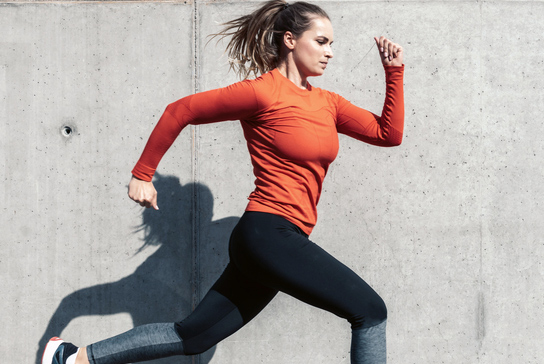V̇O2max and Aerobic Fitness
What is aerobic fitness?
Aerobic fitness (cardiovascular endurance) is the body’s ability to deliver oxygen to your muscles, which allows them to do work or engage in activity. The lungs take in oxygen from the air we breathe where it gets perfused into the blood stream; the heart and blood vessels deliver it into the working muscles; and the skeletal muscles utilize that oxygen to execute muscular contractions and produce work. A cardiovascular assessment is a good tool to measure the efficiency of the aforementioned physiological functions.


While there are numerous methods for evaluating aerobic capacity, in most instances treadmill walking/running is appropriate for the majority of individuals. Normative data correlates time on the treadmill with aerobic fitness. V̇O2 is an index of the body’s efficiency at producing work. It is expressed in milliliters of oxygen consumed per minute, and adjusted for body weight in kilograms: ml/kg/min. There are many factors that can influence V̇O2max, e.g. heredity, training, age, gender, and body composition. Generally, V̇O2max declines with age (about 2% per year after age 30) and males typically have a greater oxygen consumption value than females. Nevertheless, the trend is that a higher V̇O2 max allows one to produce more energy, thereby performing more work. With this in mind, V̇O2 max is the "gold standard" measure of overall fitness.
Aerobic fitness is assessed by having the subject perform exercise at increased loads, for 12 to 15 minutes, while breathing into a mouthpiece which collects information on inspired and expired air. A treadmill, personal bike on a Computrainer, or a stationary bicycle are typically used. The test starts with an easy-moderate work load which is maintained for a 1-2 minutes. The load is increased gradually every 1-2 minutes until reaching the maximum level that the subject can tolerate and/or until physiological parameters such as heart rate, oxygen consumption, f... have hit a peak or plateau. This is done by increasing the cycling resistance or the speed and/or grade of the treadmill. The oxygen uptake, heart rate, speed and/or watts are measured at the ventilatory threshold and at maximal load, the latter would be the subject's V̇O2 max.
V̇O2 max values cannot be used in every day training, but follow-up V̇O2 tests can be used as a measure of progress. However, since heart rate, speed and/or power is typically measured during a V̇O2 max test, various heart rate, speed and/or power levels can be garnered from testing and then associated to appropriate training zones, which are then applied to everyday training. Other information such as V̇O2 economy (oxygen consumption values at a given heart rate or power output) can also be extracted from the data, compared to subsequent tests and against performance norms.
Training results in an increase in the efficiency of oxygen transport within the body. By lowering the resting heart rate (HR), and the HR at sub maximal loads, the heart pumps more blood with every heart beat. This, in addition to other physiological changes, increases the oxygen extraction capability. When an individual is tested before and after training while performing exercise at the same load, a lower HR is shown after training because more blood (thus, oxygen) is delivered in each heart beat. Such HR differences during exercise can be used to predict aerobic fitness. The % of increase in V̇O2 max is dependent on many variables and differs considerably from individual to individual, ranging from 5-30%. In general, individuals who are the least fit see the largest changes and individuals who are highly fit see the smallest changes.
Significant amounts of research and public health data indicate that low aerobic fitness levels are correlated with an increased risk of premature death from many causes but in particular from cardiovascular disease. Accordingly, higher aerobic fitness levels are associated with numerous health benefits e.g. longer lifespan, better quality of life, reduced risks for stroke, heart disease, diabetes and cancer, improved mood and self-esteem, and improved sleep patterns. To improve or maintain cardiovascular health an individual must engage in cardiovascular exercise (run, walk, swim, bike, etc...) at least 3 times per week. Currently, however, public health data indicates that only 22-25% of Americans exercise regularly enough to achieve these positive health benefits.
V̇O2 max is also a predictor of performance, although its correlation to athletic success in endurance sports is only 30-40%, with other factors such as sustainable lactate threshold, motivation, training, etc... also playing a role. In general, however the higher a V̇O2 max the more potential for a successful performance in an aerobic endurance event.
